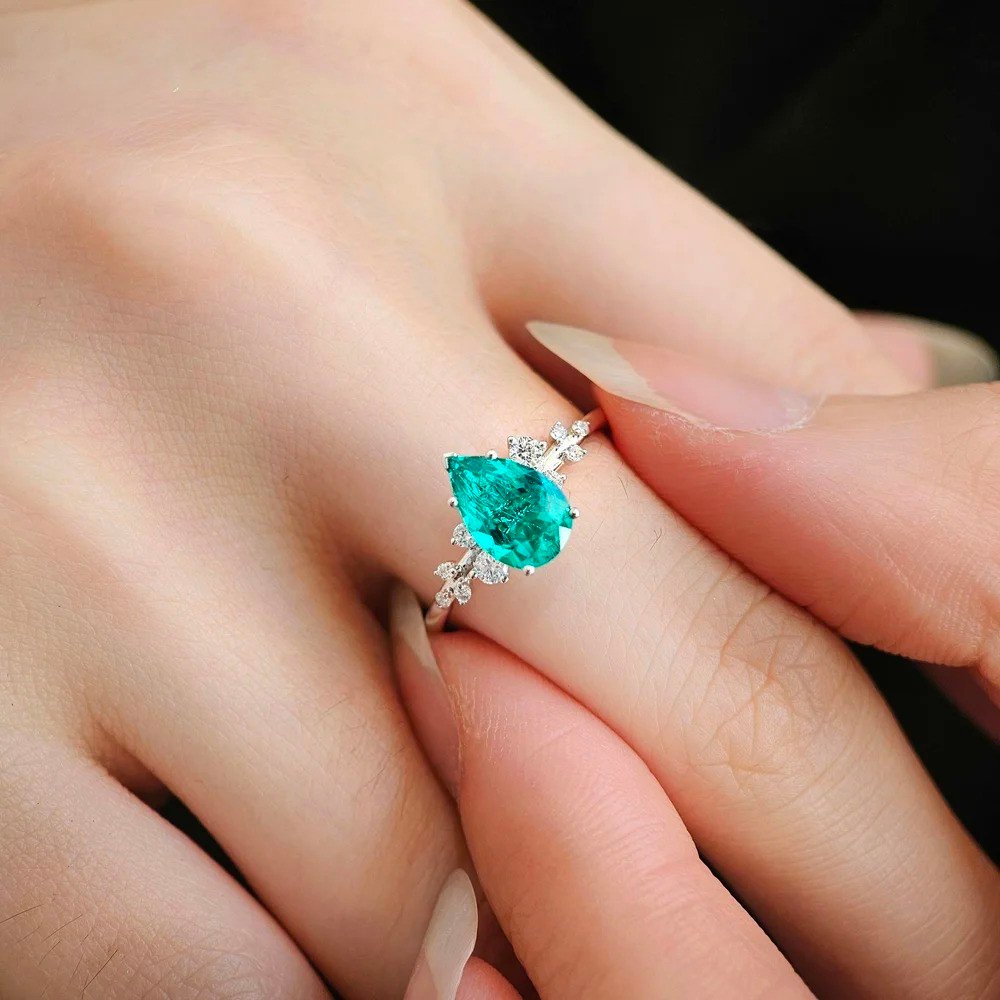Introduction
Lab-created emerald rings have surged in popularity as modern shoppers look for beautiful gemstones that align with ethical, budget, and quality priorities. Unlike mined emeralds that form deep in the earth over millions of years, lab-created emeralds are produced in controlled environments to replicate the chemical and physical properties of natural stones. The result is a gem that often matches or even exceeds natural emeralds in clarity and color while costing significantly less and carrying a smaller environmental footprint. This guide explains what lab-created emeralds are, how they’re made, how they compare to natural stones, buying tips to get the best value, and how to care for your ring so it lasts for generations. Read on for practical, trustworthy advice grounded in industry best practices to help you choose confidently.
What exactly are lab-created emeralds?
Lab-created emeralds are real beryllium aluminum silicate gemstones that possess the same chemical composition, crystal structure, and optical properties as natural emeralds; the key difference is origin. Rather than forming within the Earth’s crust, these emeralds are synthesized in laboratories using techniques such as hydrothermal growth or flux-growth processes. Hydrothermal methods mimic natural high-pressure, high-temperature conditions with mineral-rich solutions, while flux growth uses a molten solvent to encourage crystal formation. Because labs control variables like temperature, growth speed, and chemical purity, lab-created emeralds tend to have fewer inclusions and more consistent color than many mined counterparts. Independent gemological labs can identify origin using advanced instruments, and respected sellers will provide certification and details about the growth method, size, cut, and treatments so you know what you’re buying.
How lab-created emeralds compare to natural emeralds
When choosing between lab-created and natural emeralds, consider both science and sentiment. Physically and optically, a lab-created emerald can be virtually indistinguishable from a natural one to the unaided eye: both refract light similarly, show comparable brilliance, and can be cut to beautiful shapes. Differences emerge in inclusions, price, and provenance. Natural emeralds commonly contain visible inclusions “jardin” (garden-like patterns) which many buyers prize as part of a stone’s story; lab stones often show far fewer internal features and therefore greater clarity. Price-wise, lab-created emeralds typically cost a fraction of mined stones of similar size and color, offering more carat for the budget. From a provenance perspective, lab-created gems avoid many environmental and social risks linked to mining. Ultimately the choice depends on whether you prioritize rarity and geological history (natural) or value, consistency, and ethical sourcing.
Benefits of choosing a lab-created emerald ring
Lab-created emerald rings deliver several concrete advantages that appeal to modern buyers. First, value: you’ll usually get a larger, clearer stone for the same price as a smaller natural emerald. Second, clarity and color consistency: controlled growth processes reduce inclusions and create vivid, even color that translates into striking rings. Third, ethics and sustainability: lab gems avoid mining-related habitat disruption, hazardous waste, and complex labor issues, making them an attractive option for ethically minded consumers. Fourth, predictability: because labs produce stones in controlled batches, buyers can expect repeatable quality and accurate grading. Finally, great for fashion and everyday wear designers can offer bolder sizes and experimental cuts without the prohibitive cost of comparable mined gems. These benefits make lab-created emeralds especially compelling for engagement rings, anniversary gifts, and fashion-forward fine jewelry.
How to choose the best lab-created emerald ring: a practical buying guide
Start with color and cut color is paramount for emeralds; seek a vivid green with balanced saturation and medium-dark tone. Cut affects brilliance and perceived size, so choose a cut (emerald, oval, cushion, or round) that maximizes light return and suits your taste. Check carat weight and dimensions, but remember that depth and cut quality influence how large a gem appears. Ask for independent certification from a reputable lab that states origin (lab-created), treatment history, and measurements. Verify the seller’s return policy, warranty, and repair options reputable jewelers offer resizing, polishing, and secure settings. Consider the setting metal and design: emeralds look beautiful in yellow gold for a vintage feel, or in platinum/white gold for a modern contrast. Finally, request clear photos or videos, ask about after-sales service, and compare multiple sellers to ensure fair pricing and trustworthy documentation.
Caring for and maintaining your lab-created emerald ring
Emeralds lab-created or natural are relatively hard but can be more brittle than diamonds; they require gentle care to keep their color and integrity. Avoid harsh chemical cleaners and extreme temperature shifts; use warm water, mild dish soap, and a soft brush for regular cleaning. For deeper cleanings or if your ring has multiple stones and intricate settings, have it professionally cleaned and checked once a year to ensure prongs are secure. Remove your ring during heavy manual labor, sports, or tasks involving solvents and abrasive materials. If your lab-created emerald has oil or resin treatments (sometimes applied to enhance clarity), disclose this to a jeweler before any ultrasonic cleaning some treatments can be sensitive to ultrasonic waves. Finally, store the ring separately from other jewelry to prevent scratches and consider insuring high-value pieces to protect against loss, theft, or accidental damage.
Conclusion
Lab-created emerald rings offer an attractive balance of beauty, value, and ethical clarity, making them an excellent choice for buyers seeking sustainable fine jewelry without sacrificing style. They match many of the visual and physical properties of natural emeralds while providing more predictable clarity and a friendlier price point. Whether you choose a lab-created stone for an engagement ring, a meaningful gift, or a fashion-forward piece, prioritize certified origin, quality cut and setting, and trustworthy after-sales policies. With proper care, a lab-created emerald ring can be a lifelong heirloom beautiful, principled, and perfectly suited to modern tastes.
FAQs
Q: Are lab-created emeralds real gemstones?
A: Yes. Lab-created emeralds are chemically, physically, and optically the same species as natural emeralds; the difference is they are grown in controlled laboratory conditions rather than formed in the Earth.
Q: Will a jeweler/reseller accept lab-created emeralds for appraisal or insurance?
A: Many do. Ensure the stone is certified and disclose origin when obtaining appraisals or insurance policies and appraisal values may differ from natural stones.
Q: Do lab-created emeralds lose value faster than natural emeralds?
A: Historically, lab-created gemstones have lower resale values than rare natural stones because of greater supply; however, their retail value per carat is lower upfront, offering more immediate value for buyers.
Q: Can lab-created emeralds be treated?
A: Yes—some lab-created and natural emeralds receive treatments (like oiling) to enhance clarity. Ask the seller for full disclosure and certification describing any treatments.
Q: Are lab-created emeralds sustainable?
A: Generally, yes. They avoid mining’s land disturbance and many social issues, but energy consumption and lab practices vary ask sellers about sustainable production methods if this matters to you.
Q: How do I verify a lab-created emerald?
A: Request a report from a reputable gemological laboratory that specifies origin, measurements, treatments, and any identifying features. Reputable jewelers will provide or arrange such documentation.









